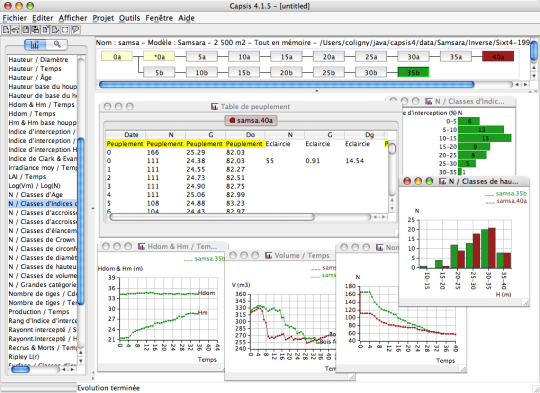Capsis
Contents
General System description
System name: Capsis - Computer Aided Projections of Strategies In Silviculture
Acronym: Capsis
Brief overview
Capsis is a software platform aimed at simulation growth and silvicultural treatments for decision making in forest management, forestry research (hypotheses testing, model evaluation) and educational purposes.
Scope of the system
Capsis is a simulation platform for forestry growth / dynamics models. It is a tool for forestry researchers, forest managers and educational purposes. It makes possible to implement models of various types (stand models, distance-independent or distance-dependent tree models, mixt models…), to run simulations and then compare the different scenarios in the same tool.
Thanks to its flexible architecture, it is possible to integrate heterogeneous models (uneven-aged, several species) with various processes (growth, competition, mortality, regeneration…) and to run simulations in interactive or script modes. Some models can have very particular properties, e.g. radiative balance, genetics information at the individual level, internal biomechanics or wood quality.
System origin
- The first version was developped by Philippe Dreyfus between 1993-1999
- Since 1999 the platform is developed by François de Coligny, joined by Samuel Dufour in 2008
Support for specific issues
Support for specific thematic areas of a problem type
Capability to support decision making phases
Related systems
Data and data models
Typical spatial extent of application
The normal spatial application level of Capsis is the stand level but can be extended to the forest level for specific models.
Forest data input
Capsis input information are
- inventory data that can be imported from files
- simulated data calcultated by specific algorithms
Type of information input from user (via GUI)
Each model integrated in capsis has its own GUI. This gui allow to set the model input parameters. These parameters depends of the model. There are different type of inputs :
- Initial parameters
- Evolution parameters
- Intervention parameters
Models
Forest models
There are more than 40 models integrated in Capsis : see capsis models.
- stand models
- diameter class models
- distance independant tree models
- distance dependant tree models
Social models
-Not available yet
Decision Support
Definition of management interventions
Capsis supports different type of generic interventions :
- by age, by height, by diameter class...
Each model can also implements specific intervention mechanisms.
Typical temporal scale of application
The temporal depends of the model.
Types of decisions supported
Decision-making processes and models
Output
Types of outputs
- stand level table and graphical outputs showing the temporal changes of its parameters
- stand level 2D viewer
- stand level 3D viewer
Spatial analysis capabilities
- facilitates links to GIS with geotools java library
Abilities to address interdisciplinary, multi-scaled, and political issues
System
System requirements
- Operating Systems: Linux / Windows / Mac Os X
- Other software needed : Java 1.6
Architecture and major DSS components
Desktop application
Usage
Research level use
Computational limitations
System memory limitation
User interface
Capsis provides :
- an interactive graphical user interface
- a script mode (without gui) based on groovy
Documentation and support
See Capsis web site [1] : capsis web site
Installation
- a free and open source version is available on the web : http://capsis.cirad.fr/capsis/download
References
Cited references
External resources
- de Coligny F., 2007. Efficient Building of Forestry Modelling Software with the Capsis Methodology. In: Fourcaud T, Zhang XP, eds. Plant Growth Modeling and Applications. Proceedings of PMA06. Los Alamitos, California: IEEE Computer Society, pp. 216-222.
